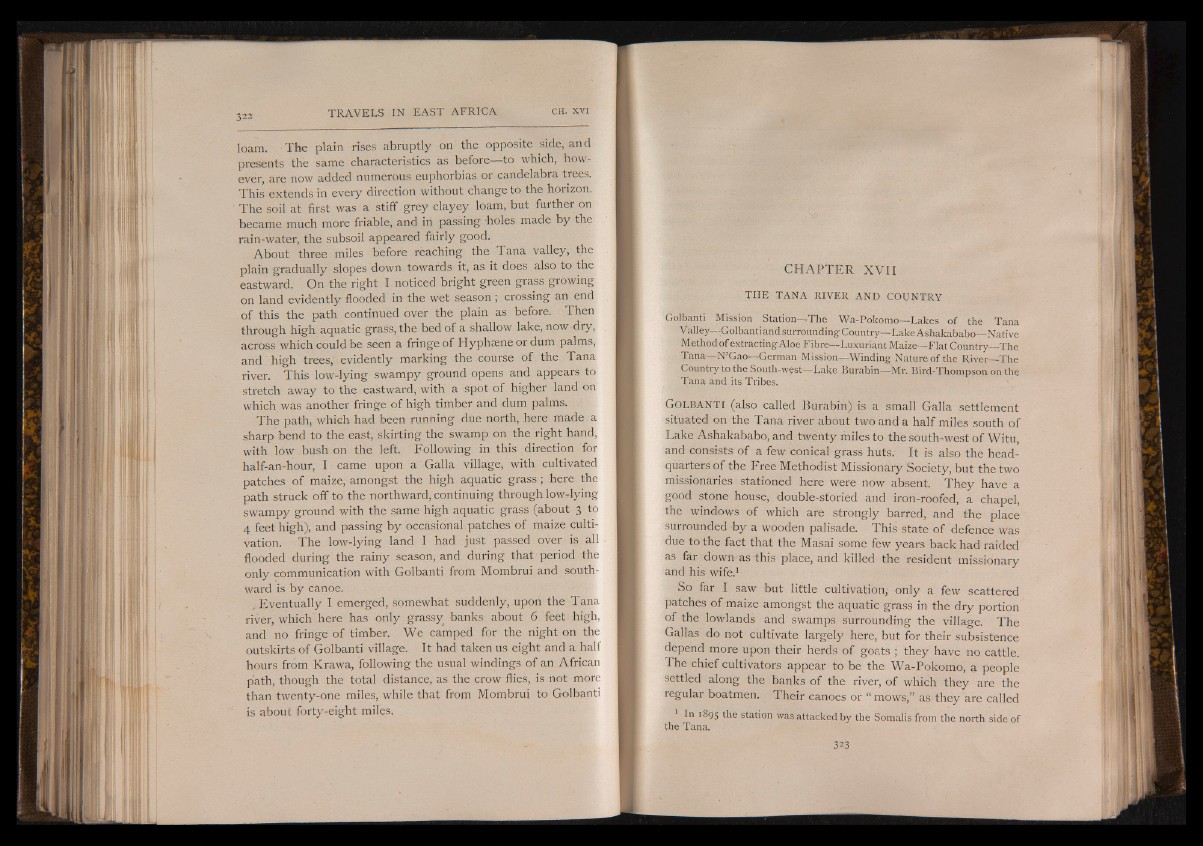
loam. The plain rises abruptly on the opposite side, and
presents the same characteristics as before— to which, however,
are now added numerous euphorbias or candelabra trees.
This extends in every direction without change to the horizon.
The soil at first was a stiff grey clayey loam, but further on
became much more friable, and in passing holes made by the
rain-water, the subsoil appeared fairly goqd.
About three miles before reaching the Tana valley, the
plain gradually slopes down towards it, as it does also to the
eastward. On the right I noticed bright green grass growing
on land evidently flooded in the wet season; crossing an end
of this the path continued over the plain as before. Then
through high aquatic grass, the bed of a shallow lake, now dry,
across which could be seen a fringe of Hyphsene or dum palms,
and high trees,' evidently marking the course of the Tana
river. This low-lying swampy ground opens and appears to
stretch away to the eastward, with a spot of higher land on
which was another fringe of high timber and dum palms.
The path, which had been running due north, here made a
sharp bend to the east, skirting the. swamp on the right hand,
with low bush on the left. Following in this direction for
half-an-hour, I came upon a Galla village, with cultivated
patches of maize, amongst the high aquatic grass; here the
path struck off to the northward, continuing through low-lying
swampy ground with the same high aquatic grass (about 3 to
4 feet high), and passing by occasional patches of maize cultivation.
The low-lying land I had just passed over is all
flooded during the rainy season, and during that period the
only communication with Golbanti from Mombrui and southward
is by canoe.
_ Eventually I emerged, somewhat suddenly, upon the Tana
river, which here has only grassy^ banks about 6 feet high,
and no fringe of timber. We camped for the night on the
outskirts of Golbanti village. It had taken us eight and a half
hours from Krawa, following the usual windings of an African
path, though the total distance, as the crow flies, is not more
than twenty-one miles, while that from Mombrui to Golbanti
is about forty-eight miles, .
CH AP TER X V II
THE TANA RIVER AND COUNTRY
Golbanti Mission Station—-The Wa-Pokomo— Lakes of the Tana
Valley-.Golbanti and surrounding Country— Lake Ashakababo^Native
Method of extracting Aloe Fibre— Luxuriant Maize— Flat Country— The
Tana-7-N’Gao— German Mission—Winding Nature of the River— The
Country to the South-wgst— Lake Burabin— Mr. Bird-Thompson on the
Tana and its Tribes.
GOLBANTI (also called Burabin) is a small Galla settlement
situated on the Tana river about two and a half miles south of
Lake Ashakababo, and twenty miles to the south-west of Witu,
and consists of a few conical grass huts/ It is also the headquarters
of the Free Methodist Missionary Society, but the two
missionaries stationed here were now absent. They have a
good stone house, double-storied and iron-roofed, a chapel,
the windows of which are strongly barred, and the place
surrounded by a wooden palisade. This state of defence was
due to the fact that the Masai some few years back had raided
as far down as this place, arid killed the resident missionary
and his wife.1
So far I saw but little cultivation, only a few scattered
patches of maize amongst the aquatic grass in the dry portion
of the lowlands and swamps surrounding the village. The
Gallas do not cultivate largely here, but for their subsistence
depend more upon their herds of goats ; they have no cattle.
The chief cultivators appear to be the Wa-Pokomo, a people
settled along the banks of the river, of which they are the
regular boatmen. Their canoes or “ mows,” as they are called
1 In 1895 the station was attacked by the Somalis from the north side of
the Tana,